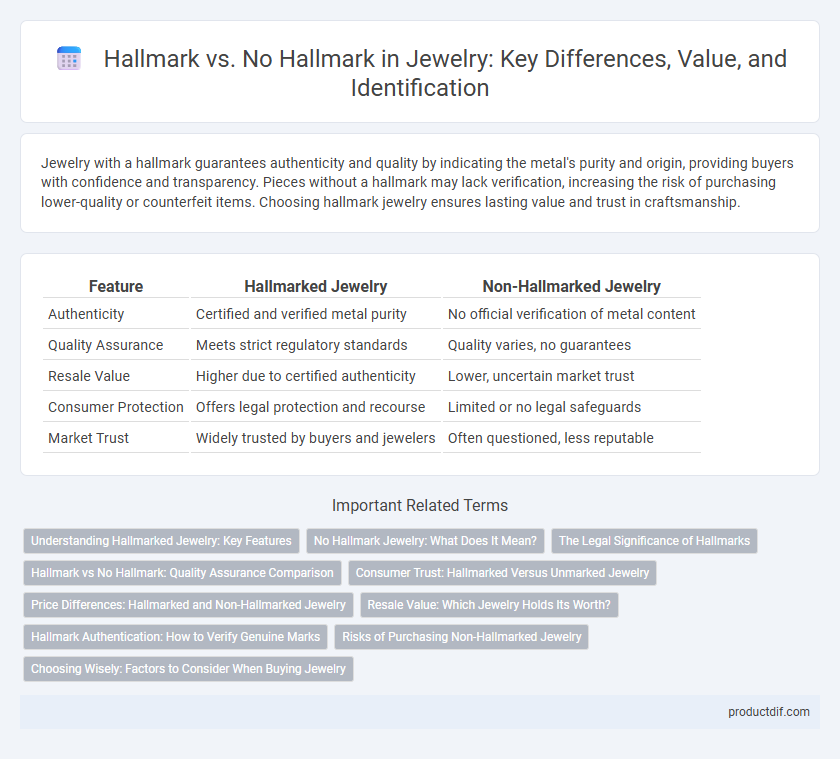Jewelry with a hallmark guarantees authenticity and quality by indicating the metal's purity and origin, providing buyers with confidence and transparency. Pieces without a hallmark may lack verification, increasing the risk of purchasing lower-quality or counterfeit items. Choosing hallmark jewelry ensures lasting value and trust in craftsmanship.
Table of Comparison
| Feature | Hallmarked Jewelry | Non-Hallmarked Jewelry |
|---|---|---|
| Authenticity | Certified and verified metal purity | No official verification of metal content |
| Quality Assurance | Meets strict regulatory standards | Quality varies, no guarantees |
| Resale Value | Higher due to certified authenticity | Lower, uncertain market trust |
| Consumer Protection | Offers legal protection and recourse | Limited or no legal safeguards |
| Market Trust | Widely trusted by buyers and jewelers | Often questioned, less reputable |
Understanding Hallmarked Jewelry: Key Features
Hallmarked jewelry carries official stamps indicating the metal's purity and authenticity, offering assurance of quality and value. These marks include the maker's stamp, assay office mark, metal type, and fineness number, which are internationally recognized standards. Jewelry without a hallmark may lack verified quality, increasing the risk of counterfeit metals or inferior materials.
No Hallmark Jewelry: What Does It Mean?
No hallmark jewelry indicates the piece lacks official stamps verifying its metal purity or authenticity, which may affect its value and trustworthiness. Such items can be crafted from non-precious metals, plated materials, or lower-quality alloys, often making them less durable and potentially causing allergic reactions. Consumers should carefully assess the source, craftsmanship, and material composition when purchasing jewelry without a hallmark to avoid counterfeit or substandard products.
The Legal Significance of Hallmarks
Hallmarks serve as legally recognized stamps certifying the purity and authenticity of precious metals, providing consumer protection and ensuring compliance with national standards. Jewelry items bearing hallmarks offer verified assurance of metal content, thereby reducing the risk of fraud and enhancing market trust. In contrast, pieces without hallmarks lack official verification, potentially exposing buyers to counterfeit or substandard materials and complicating legal recourse in disputes.
Hallmark vs No Hallmark: Quality Assurance Comparison
Hallmarked jewelry guarantees authenticity and quality, as it is certified by official assay offices for metal purity, ensuring compliance with industry standards. In contrast, jewelry without a hallmark carries a higher risk of containing lower-grade metals or counterfeit materials, leading to potential value depreciation and allergic reactions. Consumers prioritizing long-term investment and trust should opt for hallmarked pieces to secure verified precious metal content and craftsmanship excellence.
Consumer Trust: Hallmarked Versus Unmarked Jewelry
Hallmarked jewelry guarantees authenticity and metal purity, boosting consumer confidence by verifying its quality through recognized assay offices. Unmarked jewelry lacks official certification, which may raise concerns about its material integrity and reduce buyer trust. Consumers tend to prefer hallmarked pieces as they assure accountability and ease in reselling or insuring valuable items.
Price Differences: Hallmarked and Non-Hallmarked Jewelry
Hallmarked jewelry commands higher prices due to guaranteed authenticity, metal purity, and quality assurance verified by official assay offices. Non-hallmarked pieces typically cost less but pose risks of lower metal content, counterfeit materials, and reduced resale value. Buyers often pay a premium for hallmarked items as a safeguard against fraud and to ensure long-term investment security.
Resale Value: Which Jewelry Holds Its Worth?
Jewelry with a hallmark certifies metal purity and authenticity, significantly enhancing its resale value compared to non-hallmarked pieces. Hallmarked items from reputable brands or precious metals such as gold, platinum, and silver maintain higher market demand and offer better guarantees for buyers, ensuring sustained investment worth. Non-hallmarked jewelry often faces depreciation due to doubts over material quality, limiting its appeal and resale potential in the secondary market.
Hallmark Authentication: How to Verify Genuine Marks
Hallmark authentication involves verifying official stamps on jewelry that certify metal purity, typically gold, silver, or platinum, ensuring quality and authenticity. Genuine hallmarks are issued by authorized assay offices and include specific symbols, numbers indicating karat or fineness, and sometimes a maker's mark, which must be cross-checked against recognized databases or official registries. Absence of a hallmark increases the risk of counterfeit materials, making hallmark verification crucial for buyers seeking trusted value in precious metal jewelry.
Risks of Purchasing Non-Hallmarked Jewelry
Purchasing non-hallmarked jewelry carries significant risks including uncertainty about metal purity, which can lead to financial loss or allergic reactions from substandard materials. Without an official hallmark, verification of authenticity becomes difficult, increasing the chance of counterfeit or misrepresented items. Consumers may face legal issues when reselling unmarked jewelry, as many countries require hallmarks for taxation and import regulations.
Choosing Wisely: Factors to Consider When Buying Jewelry
Hallmarked jewelry guarantees authenticity, metal purity, and compliance with industry standards, providing assurance of quality and value. Non-hallmarked pieces may lack verified metal content, increasing the risk of counterfeit or subpar materials. When buying jewelry, prioritize hallmark inspection, seller reputation, and detailed product certification to ensure a wise investment.
Hallmark vs no hallmark Infographic

 productdif.com
productdif.com